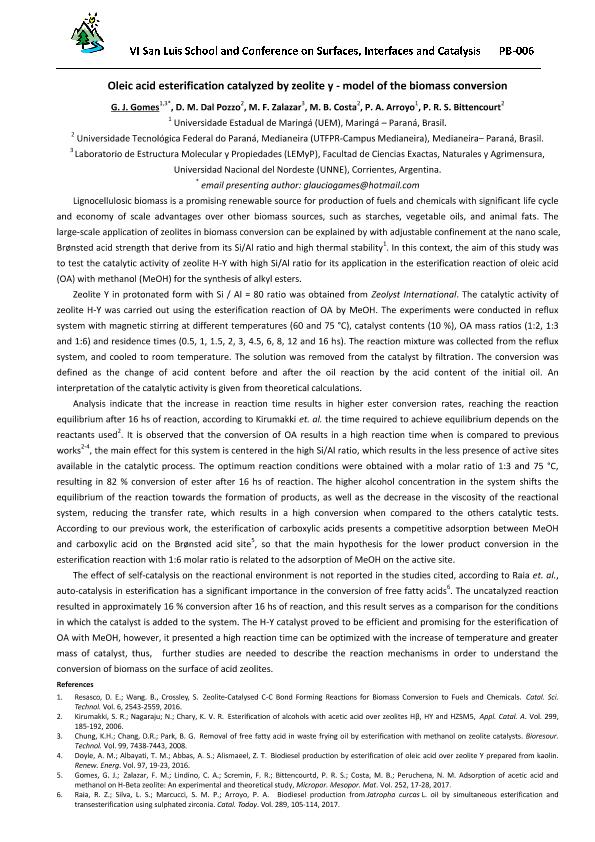Evento
Oleic acid esterification catalyzed by zeolite y - model of the biomass conversion
Gomes, Glaucio José; Dal Pozzo, Daniel M.; Zalazar, Maria Fernanda ; Costa, M. B.; Arroyo, Pedro Augusto; Bittencourt, Paulo R. S.
; Costa, M. B.; Arroyo, Pedro Augusto; Bittencourt, Paulo R. S.
 ; Costa, M. B.; Arroyo, Pedro Augusto; Bittencourt, Paulo R. S.
; Costa, M. B.; Arroyo, Pedro Augusto; Bittencourt, Paulo R. S.
Tipo del evento:
Conferencia
Nombre del evento:
VI San Luis School and Conference on Surfaces, Interfaces and Catalysis
Fecha del evento:
02/06/2018
Institución Organizadora:
Instituto de Investigaciones en Catálisis y Petroquímica;
Universidad Nacional del Litoral;
Título del Libro:
Book of Abstract of the VI San Luis School and Conference on Surfaces, Interfaces and Catalysis
Editorial:
Universidad Nacional del Litoral
Idioma:
Inglés
Clasificación temática:
Resumen
Lignocellulosic biomass is a promising renewable source for production of fuels and chemicals with significant life cycle and economy of scale advantages over other biomass sources, such as starches, vegetable oils, and animal fats. The large-scale application of zeolites in biomass conversion can be explained by with adjustable confinement at the nano scale, Brønsted acid strength that derive from its Si/Al ratio and high thermal stability1. In this context, the aim of this study was to test the catalytic activity of zeolite H-Y with high Si/Al ratio for its application in the esterification reaction of oleic acid (OA) with methanol (MeOH) for the synthesis of alkyl esters. Zeolite Y in protonated form with Si / Al = 80 ratio was obtained from Zeolyst International. The catalytic activity of zeolite H-Y was carried out using the esterification reaction of OA by MeOH. The experiments were conducted in reflux system with magnetic stirring at different temperatures (60 and 75 °C), catalyst contents (10 %), OA mass ratios (1:2, 1:3 and 1:6) and residence times (0.5, 1, 1.5, 2, 3, 4.5, 6, 8, 12 and 16 hs). The reaction mixture was collected from the reflux system, and cooled to room temperature. The solution was removed from the catalyst by filtration. The conversion was defined as the change of acid content before and after the oil reaction by the acid content of the initial oil. An interpretation of the catalytic activity is given from theoretical calculations.Analysis indicate that the increase in reaction time results in higher ester conversion rates, reaching the reaction equilibrium after 16 hs of reaction, according to Kirumakki et. al. the time required to achieve equilibrium depends on the reactants used2. It is observed that the conversion of OA results in a high reaction time when is compared to previous works2-4, the main effect for this system is centered in the high Si/Al ratio, which results in the less presence of active sites available in the catalytic process. The optimum reaction conditions were obtained with a molar ratio of 1:3 and 75 °C, resulting in 82 % conversion of ester after 16 hs of reaction. The higher alcohol concentration in the system shifts the equilibrium of the reaction towards the formation of products, as well as the decrease in the viscosity of the reactional system, reducing the transfer rate, which results in a high conversion when compared to the others catalytic tests. According to our previous work, the esterification of carboxylic acids presents a competitive adsorption between methanol and carboxylic acid on the Brønsted acid site5, so that the main hypothesis for the lower product conversion in the esterification reaction with 1:6 molar ratio is related to the adsorption of MeOH on the active site. The effect of self-catalysis on the reactional environment is not reported in the studies cited, according to Raia et. al., auto-catalysis in esterification has a significant importance in the conversion of free fatty acids6. The uncatalyzed reaction resulted in approximately 16 % conversion after 16 hs of reaction, and this result serves as a comparison for the conditions in which the catalyst is added to the system. The H-Y catalyst proved to be efficient and promising for the esterification of OA with MeOH, however, it presented a high reaction time can be optimized with the increase of temperature and greater mass of catalyst, thus, further studies are needed to describe the reaction mechanisms in order to understand the conversion of biomass on the surface of acid zeolites.
Palabras clave:
HETEROGENEOUS CATALYSIS
,
ESTERIFICATION
,
ZEOLITE
Archivos asociados
Licencia
Identificadores
Colecciones
Eventos(IQUIBA-NEA)
Eventos de INSTITUTO DE QUIMICA BASICA Y APLICADA DEL NORDESTE ARGENTINO
Eventos de INSTITUTO DE QUIMICA BASICA Y APLICADA DEL NORDESTE ARGENTINO
Citación
Oleic acid esterification catalyzed by zeolite y - model of the biomass conversion; VI San Luis School and Conference on Surfaces, Interfaces and Catalysis; Santa Fe; Argentina; 2018; 1-3
Compartir



